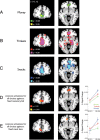Evidence for a common representation of decision values for dissimilar goods in human ventromedial prefrontal cortex
- PMID: 19793990
- PMCID: PMC6666137
- DOI: 10.1523/JNEUROSCI.2575-09.2009
Evidence for a common representation of decision values for dissimilar goods in human ventromedial prefrontal cortex
Abstract
To make economic choices between goods, the brain needs to compute representations of their values. A great deal of research has been performed to determine the neural correlates of value representations in the human brain. However, it is still unknown whether there exists a region of the brain that commonly encodes decision values for different types of goods, or if, in contrast, the values of different types of goods are represented in distinct brain regions. We addressed this question by scanning subjects with functional magnetic resonance imaging while they made real purchasing decisions among different categories of goods (food, nonfood consumables, and monetary gambles). We found activity in a key brain region previously implicated in encoding goal-values: the ventromedial prefrontal cortex (vmPFC) was correlated with the subjects' value for each category of good. Moreover, we found a single area in vmPFC to be correlated with the subjects' valuations for all categories of goods. Our results provide evidence that the brain encodes a "common currency" that allows for a shared valuation for different categories of goods.
Figures


References
-
- Barraclough D, Conroy M, Lee D. Prefrontal cortex and decision making in a mixed-strategy game. Nat Neurosci. 2004;7:404–410. - PubMed
-
- Becker G, DeGroot M, Marschak J. Measuring utility by a single-response sequential method. Behav Sci. 1964;9:226–232. - PubMed
-
- Bernoulli D. Specimen theoriae novae de mensura sortis. Reprinted in: Econometrica. 1738;22:23–36. (Sommer L, translator), 1954.
-
- Brainard D. The psychophysics toolbox. Spat Vis. 1997;10:433–436. - PubMed
-
- Buchel C, Morris J, Dolan R, Friston K. Brain systems mediating aversive conditioning: an event-related fMRI study. Neuron. 1998;20:947–957. - PubMed
Publication types
MeSH terms
LinkOut - more resources
Full Text Sources
